Gold Price Chart: XAU Breakout Testing Resistance at Six-Year Highs - DailyFX
Gold Price Chart: XAU Breakout Testing Resistance at Six-Year Highs - DailyFX |
- Gold Price Chart: XAU Breakout Testing Resistance at Six-Year Highs - DailyFX
- Sterling Dollar Price Chart: GBP/USD Recovery Fails at Yearly Open - DailyFX
- The Head and Shoulders Pattern: A Trader’s Guide - DailyFX
- Apply "the secret" to forex trading success - ForexLive
| Gold Price Chart: XAU Breakout Testing Resistance at Six-Year Highs - DailyFX Posted: 25 Jun 2019 09:16 AM PDT Gold prices have surged nearly 13% off the yearly lows with the advance probing fresh six-year highs today in New York. The breakout is testing initial resistance targets today at the late-2013 swing highs with daily momentum deep in overbought territory. While the broader outlook remains constructive, the advance may be vulnerable near-term while below today's highs. These are the updated targets and invalidation levels that matter on the XAU/USD charts this week. Review this week's Strategy Webinar for an in-depth breakdown of this Gold setup and more. New to Gold Trading? Get started with this Free How to Trade Gold -Beginners Guide Gold Price Chart - XAU/USD Daily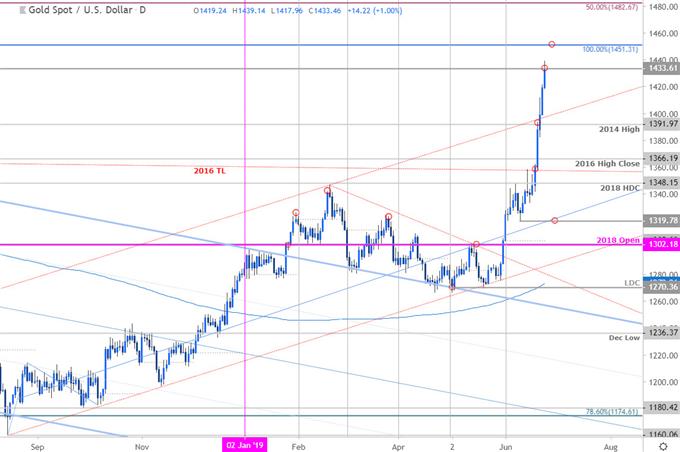 Technical Outlook: In my latest Gold Price Weekly Outlook we noted that a weekly close above 1392 was needed to keep the immediate long-bias viable targeting, "subsequent topside objectives at 1433 and the 100% extension of the late-2015 advance at 1451- look for a bigger reaction there IF reached." Price registered a high at 1439 today before puling back into the 1433 zone early in US trade. While the broader outlook remains constructive, a daily close below this threshold would leave the immediate advance vulnerable. No significant support emerges until 1391 with broader bullish invalidation at 1366. A topside breach from here keeps the focus on the 100% extension of the late-2015 advance at 1451 (critical) backed by the 50% retracement of the 2011 decline at 1482. Why does the average trader lose? Avoid these Mistakes in your trading Bottom line: The immediate Gold price advance is vulnerable while below the 1433. From a trading standpoint, a good spot to reduce long-exposure / raise protective stops. Be on the lookout for possible near-term exhaustion IF price fails to close above today. Ultimately a larger pullback may offer more favorable long-entries while above former slope resistance / 1391. Review our latest Gold 2Q forecasts for a longer-term look at the technical picture for XAU/USD prices. For a complete breakdown of Michael's trading strategy, review his Foundations of Technical Analysis series on Building a Trading Strategy Gold Trader Sentiment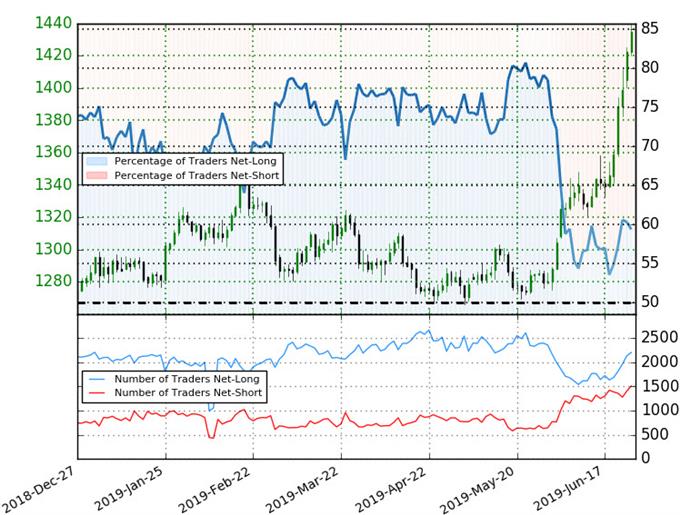
See how shifts in Gold retail positioning are impacting trend- Learn more about sentiment! --- Active Trade Setups- Written by Michael Boutros, Currency Strategist with DailyFX Follow Michael on Twitter @MBForex | ||||||||||
| Sterling Dollar Price Chart: GBP/USD Recovery Fails at Yearly Open - DailyFX Posted: 25 Jun 2019 10:38 AM PDT The British Pound rallied more than 2.2% off the June lows with the advance failing to breach / close above the monthly opening-range highs / yearly open resistance. These are the updated targets and invalidation levels that matter on the GBP/USD charts into the close of the month. Review this week's Strategy Webinar for an in-depth breakdown of this setup and more. New to Forex Trading? Get started with this Free Beginners Guide Sterling Price Chart - GBP/USD Daily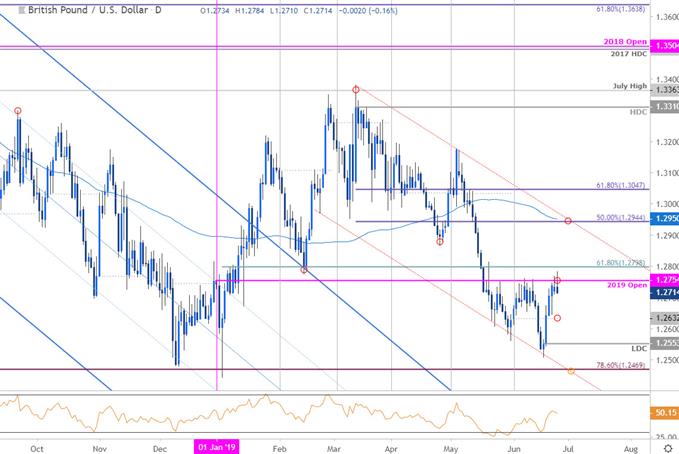 Technical Outlook: A five-day rally in the British Pound covered the entire June range with price struggling once again to breach above objective yearly open resistance at 1.2754. Note that the 61.8% retracement of the yearly range rests just higher at 1.2798 and ultimately, a breach / close above this threshold is needed to suggest that a more significant Sterling low is in place. Subsequent topside resistance objectives at the April lows at 1.2866 and 1.2944/50. Daily support rest with the monthly open at 1.2632 – Ultimately a break below the low-day close at 1.2553 would be needed to mark resumption of the broader downtrend with such a scenario targeting the 78.6% retracement at 1.2469. Why does the average trader lose? Avoid these Mistakes in your trading Bottom line: Sterling has preserved the monthly opening-range heading into the final days of June with price failing today at yearly open resistance. From a trading standpoint, the risk is for correction off this threshold – watch today's close, an outside-day reversal would further highlight the near-term threat for a move lower in the British Pound. Ultimately, we'll want to look for support ahead of the monthly open for entries IF Cable is indeed heading higher. I'll publish an updated GBP/USD Price Outlook once we get further clarity in near-term price action. For a complete breakdown of Michael's trading strategy, review his Foundations of Technical Analysis series on Building a Trading Strategy GBP/USD Trader Sentiment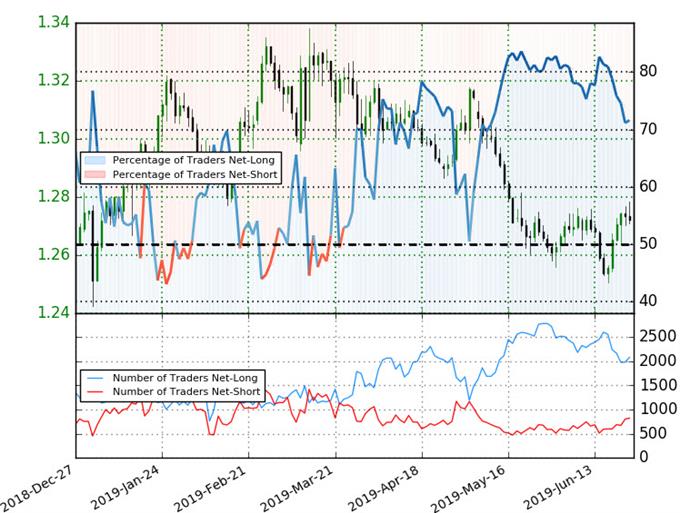
See how shifts in GBP/USD retail positioning are impacting trend- Learn more about sentiment! --- Relevant UK / US Data Releases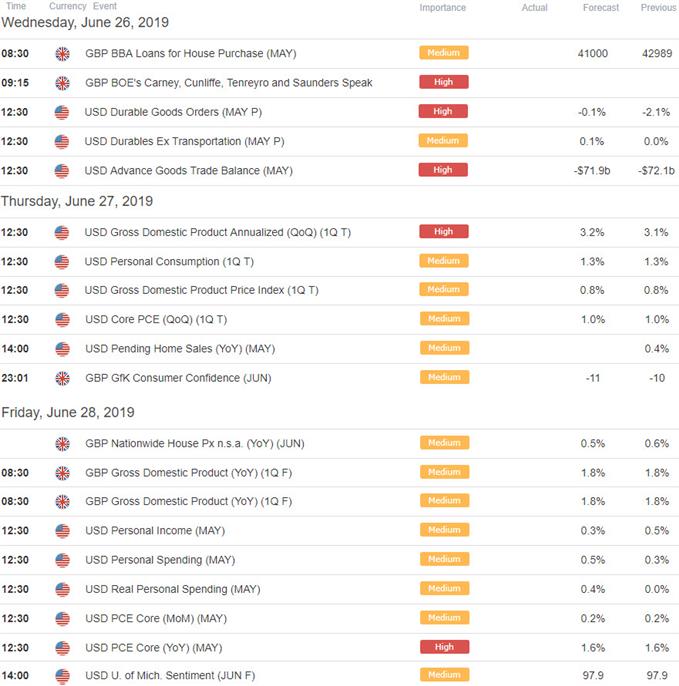 Economic Calendar - latest economic developments and upcoming event risk. Learn more about how we Trade the News in our Free Guide! Active Trade Setups- Written by Michael Boutros, Currency Strategist with DailyFX Follow Michael on Twitter @MBForex | ||||||||||
| The Head and Shoulders Pattern: A Trader’s Guide - DailyFX Posted: 25 Jun 2019 08:27 AM PDT Often considered the most steadfast of all major reversal patterns, the Head and Shoulders chart pattern is employed by novice and experience traders alike to speculate on both forex and stock markets. The benefit of this chart pattern is defined areas to set risk levels and profit targets. The inverse pattern is equally useful in any trader's arsenal and adopts the same approach as the traditional Head and Shoulders pattern. The head and shoulders stock and forex analysis process will exercise the same logic making it a great tool to include in a trader's repertoire. Head and Shoulders Chart Pattern: Main Talking Points
What is the Head and Shoulders Pattern?The Head and Shoulders chart pattern is a price reversal pattern that helps traders identify when a reversal may be underway after a trend has exhausted itself. This reversal signals the end of an uptrend. The Head and Shoulders pattern has a distinctive appearance resembling its namesake which includes a distinct 'left shoulder', 'head', 'right shoulder' and 'neckline' formation (see image below). 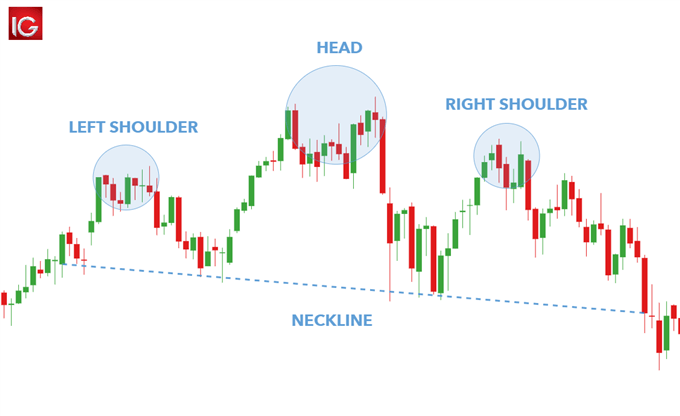 What is the Inverse Head and Shoulders Pattern?The Inverse Head and Shoulders pattern reflects the same structure as the standard version but reversed, making it observable in a downtrend (see image below). The Inverse Head and Shoulders indicates a reversal of a downtrend as higher lows are created. 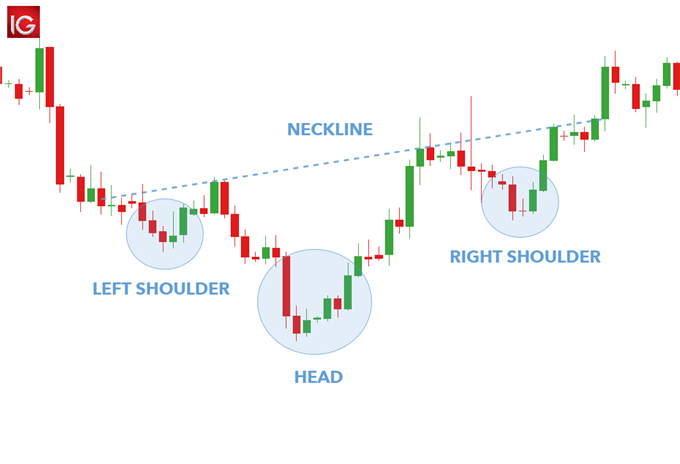 How to identify Head and Shoulders Patterns on Forex & Stock ChartsRecognizing the Head and Shoulders pattern on both forex and stock charts entail the exact same actions; making it a versatile tool to include in any trading strategy. The following list gives a simple breakdown of the key action points when identifying this pattern:
How to Trade the Head and Shoulders PatternOnce a trader knows how to identify the standard and inverse head and shoulders patterns, it's relatively easy to apply it to technical analysis in both forex and equity markets. Trading stocks with the Head and Shoulders pattern 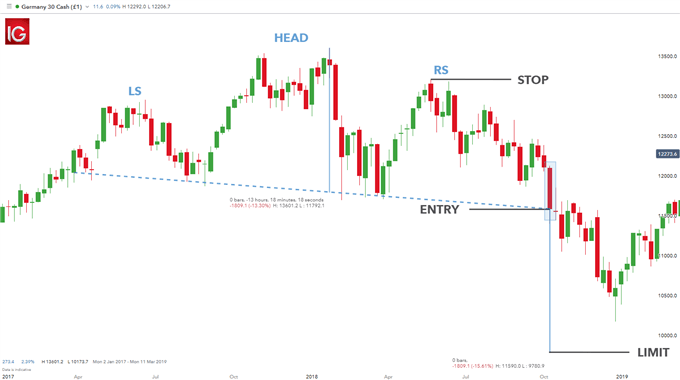 The chart above shows a Head and Shoulders pattern on the Germany 30 (DAX 30) stock index. The formation of the pattern is clear with the neckline highlighted by the dashed blue horizontal line. Traders will look to enter a short trade after a confirmation close below the neckline as seen by the 'ENTRY' label on the chart or the pip movement below the neckline. Some traders employ the 'two-day' close rule which necessitates a second confirmation candle closing below the neckline before opening the short trade. Trading on the pip break below the neckline allows traders to benefit from the full move down however, this tactic is riskier in that the breakout below the neckline has not been confirmed by a candle close. There is a general rule of thumb to designate stop and limit levels. Taking the high point off the 'right shoulder' will specify the stop level whilst the vertical distance between the neckline and high of the 'head' will approximate the limit distance – 1832.8 pips in this case. The risk-reward ratio on this trade is roughly 1:1.2 which is still within the DailyFX recommended risk management parameters. Trading forex with the Inverse Head and Shoulders pattern 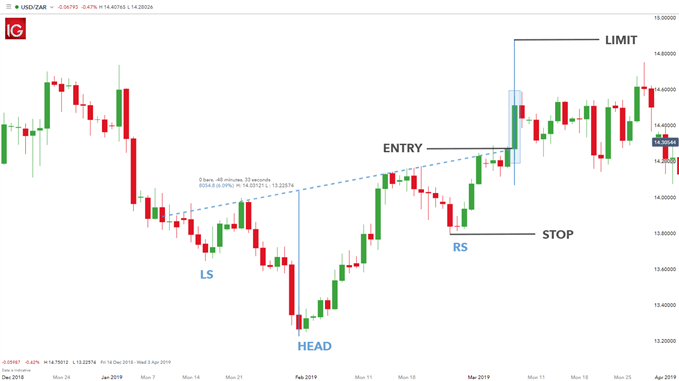 The Inverse Head and Shoulder pattern on the USD/ZAR forex pair above shows an asymmetrical structure which is quite common in most formations. The neckline is slightly skewed however, still maintaining the integrity of the pattern. The long entry level is highlighted by the neckline break or the price candle close above the neckline. The stop distance is taken from the low from the 'right shoulder' whilst the limit distance is calculated by measuring the distance from the 'head' low to the neckline. Advantages and Limitations of the Head and Shoulders Pattern
Further Reading on Forex Trading Patterns
| ||||||||||
| Apply "the secret" to forex trading success - ForexLive Posted: 19 Jun 2019 04:25 AM PDT What's "the secret" behind successful traders?
Each of these currencies is exchanged with the currency of other nations at different exchange rates-which are always in a state of flux because the market trades around the clock (Sunday through Friday). The volatility and sheer size of the market means that there is ample fluctuation to produce big profits-and losses. The challenge for the investor, as always, is to predict which direction the rates of currency pairs will fluctuate. The beginning point in any investment strategy is determining what type of analysis will be used to help guide enter and exit decisions. Investors who use fundamental analysis look at a nation's interest rates and other economic indicators when deciding to enter or exit a position. Fundamental investors tend to trade based upon news releases and economic data from the nations involved in the currency pair. Briefly, technical analysis involves the interpretation of price performance and chart patterns-all historical data. Some technical indicators used in this type of analysis include:
Technical traders do not believe that the past necessarily predicts the future-but that long- and short-term trends can be identified and exploited to help guide current decisions on entry and exit points on positions. Technical traders try to identify current trends in the Forex market to determine entry and exit points. If they are correct, they can ride a trend (in either direction) for a profit until an exit point is reached (when the trend is ending). The most successful traders on the Forex tend to look for long-term trends and favor technical analysis. Fundamental traders have to enter and exit positions very quickly in order to capitalize in price fluctuations caused by news events (interest rate changes, release of economic data, etc.) and are therefore more vulnerable due to excessive trading. If there truly was "a secret" to trading success on the Forex, the top investors all tend to agree on the following:
If there really is a secret to trading success on the Forex it has to be patience. Trading strategies are never perfect because the market will never be predictable 100% of the time. There will be times when any strategy fails and stop points are reached before profits are realized. Continuous back testing, remaining patient, and setting stops are the true secrets of Forex success. This article was submitted by UBCFX. |
| You are subscribed to email updates from "forex charts" - Google News. To stop receiving these emails, you may unsubscribe now. | Email delivery powered by Google |
| Google, 1600 Amphitheatre Parkway, Mountain View, CA 94043, United States | |

Comments
Post a Comment